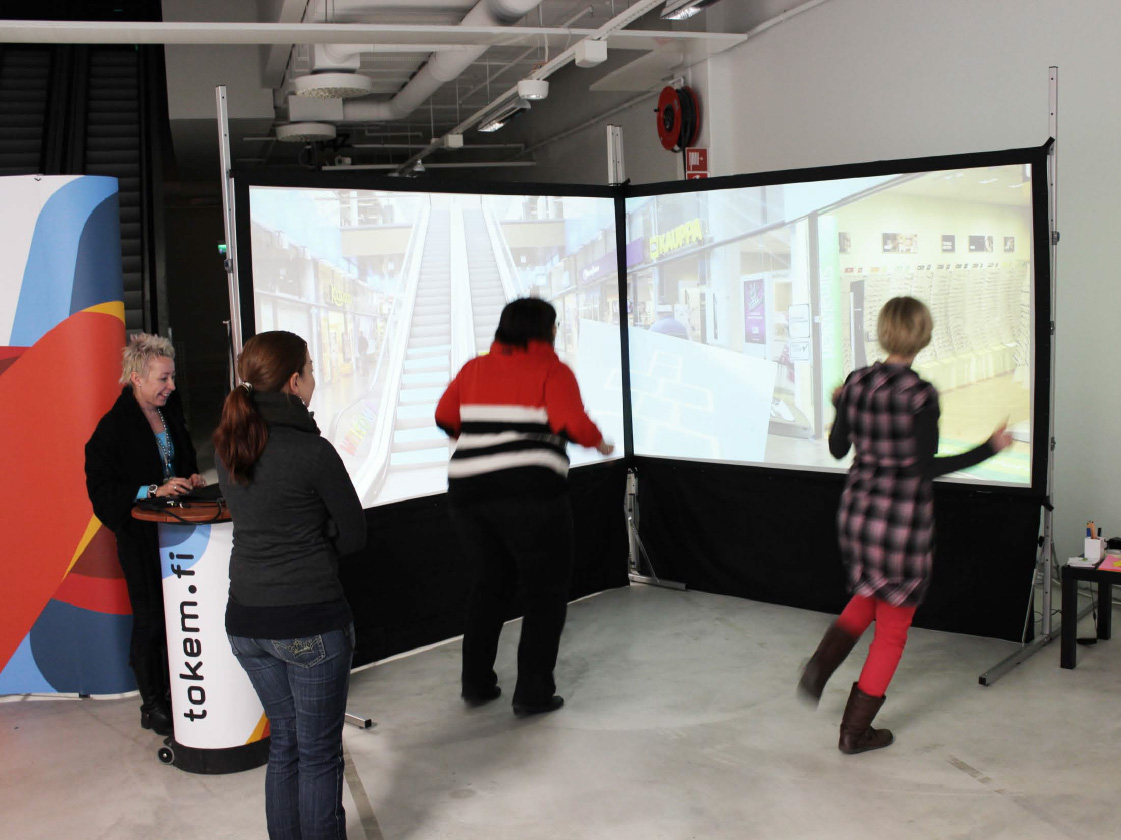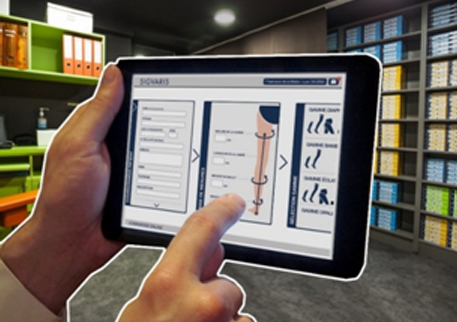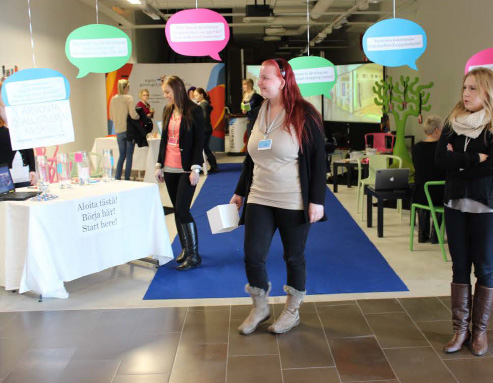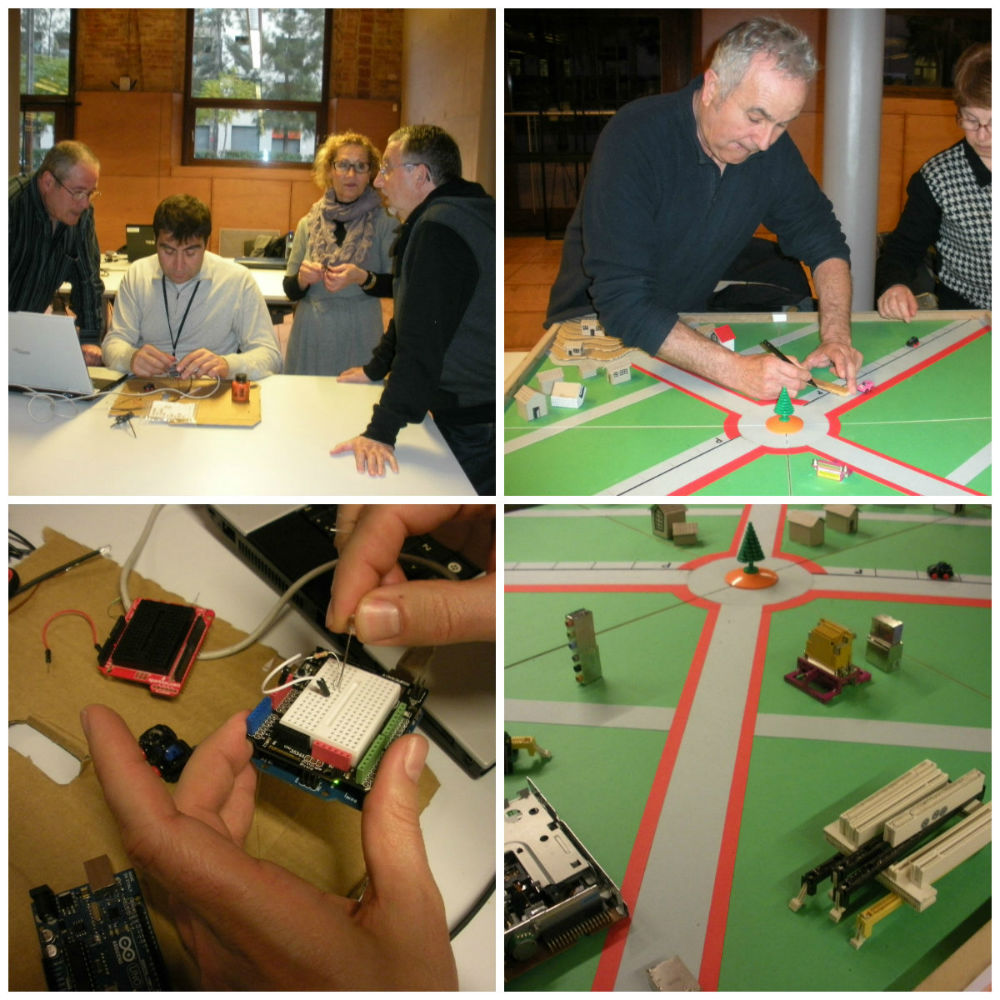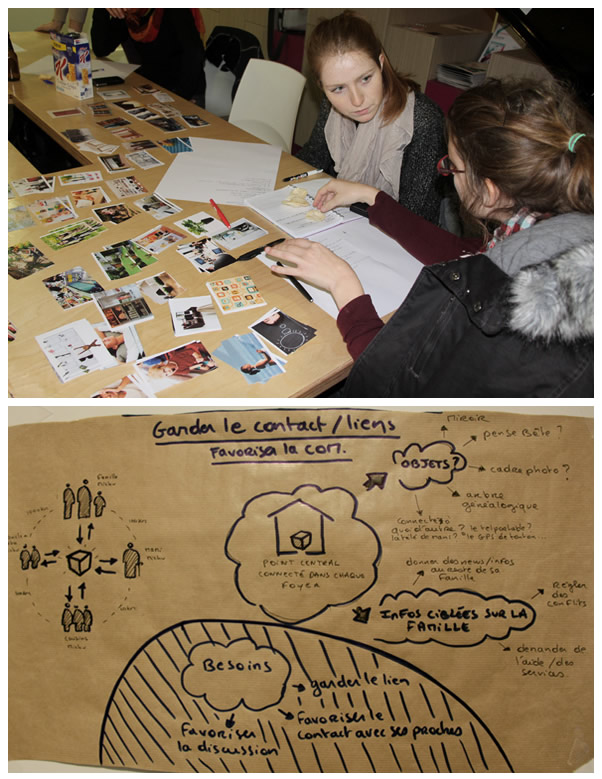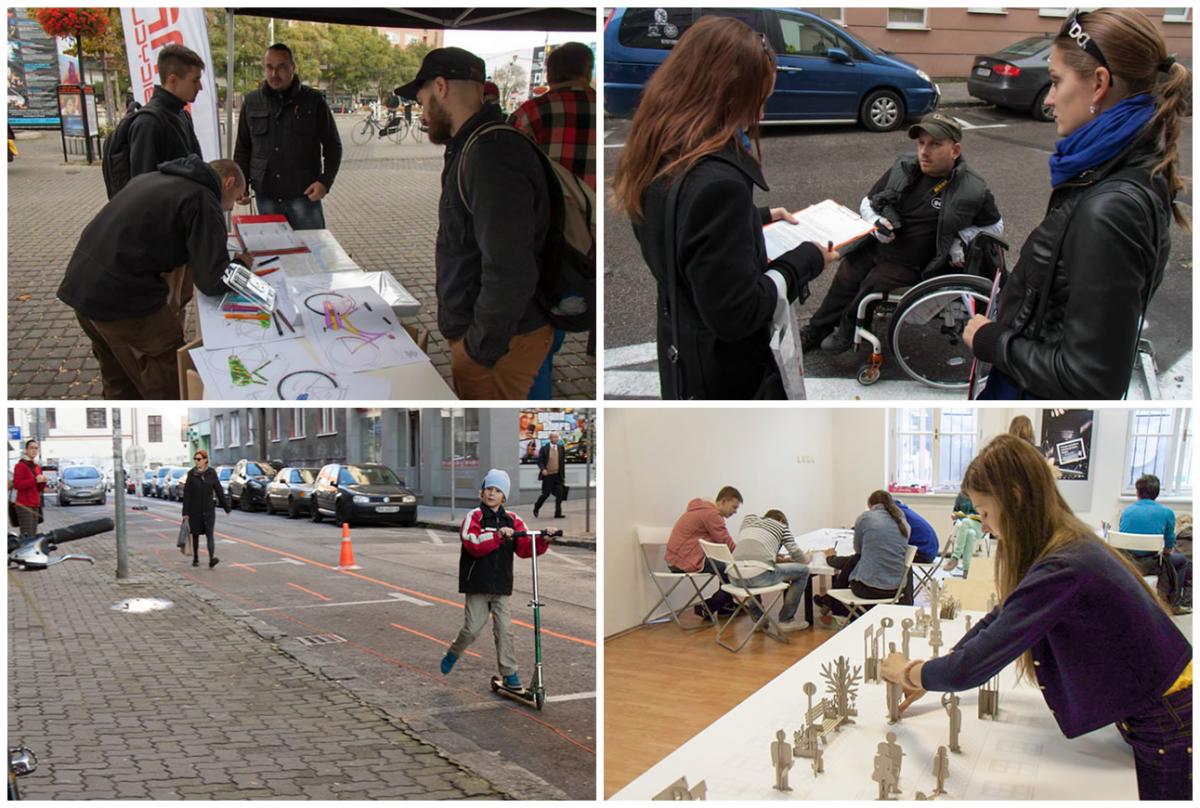AbstractDesign as a driver of user-centred innovation contributes to getting good ideas to market. It enhances agile and focused product and service development … It facilitates the development of better, transparent and more effective public services and contributes to social innovation, thereby raising the quality of life for all citizens of Europe. And for complex societal problems, design offers people-centred approaches that can achieve better solutions.
Design for Growth and Prosperity (2012)
The European Union has identified innovation as a key driver behind business competitiveness and responsive governance. However, innovation in and of itself may not be sufficient to help businesses bring new products to market and to help governments shape public services that meet the real needs of citizens. The Integrating Design for All in Living Labs (IDeALL) project sought to identify and test methodologies for designing with users in real-life settings. The results of the experiments showed how different methodologies can be applied in different contexts, helping to provide solutions to societal issues and to create products and services that genuinely meet user requirements. In this article, we describe the methodologies used in the IDeALL project and provide examples of the project's experiments and case studies across four main areas: i) services; ii) health and social care; iii) information and communication technology; and iv) urban design.
Introduction
Innovation is often promoted as essential to the prosperity and indeed survival of European economies in global markets, as exemplified at a policy level by the European Commission’s Innovation Union programme. With the rise of emerging economies, the Commission warns that its member countries may face chronic decline unless they can differentiate themselves through advances brought about by innovation. Yet, even though it may be tempting to view innovation as a magic solution, innovation in and of itself may not have a universally beneficial impact, as Rufo Quintavalle (2014) argues in his article titled "Food Doesn't Grow in Silicon Valleys".
On the macro-level, funding for research and development in Europe has not necessarily translated into innovation uptake in Europe (Curley & Salemin, 2013). On the micro-level, even in purely market terms, innovation is no guarantee of the success of a product or service, as Mulder (2012) has shown in this publication. Indeed, Gournville (2005) finds that, although "Innovation is crucial to the long-term success of many firms", "highly innovative products… fail at a greater rate than less innovative products", a phenomenon which he attributes to the need for a fundamental behaviour change that the adoption of such products requires.
Accordingly, we ask:
- How can companies lead the innovation charge while mitigating the risks of launching new products?
- How can public services evolve in such a way that they empower citizens without leaving any one group behind?
- How can design be a factor of change while leading innovation to the market?
In this article, we describe the Integrating Design for All in Living Labs (IDeALL) project, which aims to answer these questions. First, we describe how the European Union has begun to consider the discipline of design as a driver of innovation, and then we briefly explain two of the main themes of the project: design for all and living labs. Next, we explain the rationale behind the project and give examples of the methodologies collated and compared according to the different criteria used to classify them. We then provide examples and findings of some of the project's experiments and case studies across four main areas: i) services; ii) health and social care; iii) information and communication technology (ICT); and iv) urban design. Finally, we suggest further possible applications of these methodologies by other businesses and public-sector bodies.
Design as a Driver of Innovation
The European Commission has begun to address these questions at policy level in a number of ways, including a focus on non-technological innovation such as design. In 2011, it established a Design Leadership Board, whose report Design for Growth and Prosperity (Thomson & Koskinen, 2012) includes recommendations aimed at enhancing design's "long-term contribution to smart, sustainable, and inclusive growth through increased competitiveness and the pursuit of a better quality of life". The report presents design as a driver of innovation, defining it as "an activity of people-centred innovation by which desirable and usable products are defined and delivered". By bringing the end user closer to the innovation process, the report argues, the risk of launching new products and services may be reduced.
Design for all, also known as universal design in North America, is a branch of design that takes human diversity into account so that anyone, no matter what their personal characteristics and including future generations, can access goods, services, and environments and hence can participate fully in society (Aragall and Montaña, 2012). Although technology brings new possibilities, it can be a barrier as well as a facilitator (Steinfeld and Maisel, 2012); design for all seeks to ensure that technological innovation is tied to social progress, as suggested by design-for-all professional Rafael Montes in an interview cited in the Design for All Foundation Awards brochure (Design for All Foundation, 2013).
Design for all emphasizes the importance of involving users in the design process, because this means the end result is more likely to meet their needs. This view has traditionally put the discipline at odds with the "lone genius" stereotype of the designer; however, as Design for Growth and Prosperity suggests, this model is becoming increasingly discredited, as "the complexities of innovation call for a truly multidisciplinary approach" that involves users at all stages. Although many designers adopt a design-for-all approach as a matter of principle, successes such as the OXO product range imply that it has a role in bringing successful innovations to market (Aragall and Montaña, 2012; Steinfeld and Maisel, 2012). Steinfeld and Maisel suggest that universal design can help companies bridge the gap between innovations brought about by research, such as the synthesis of a new material, to a successful product launch through a holistic development approach that focuses on the end user; this point is also illustrated in IDeALL experiment with the company Lékué, as discussed below.
The emergence of living labs has provided a mechanism for precisely this kind of multidisciplinary, co-creative approach, allowing companies to test products with users and public bodies to try new ways of providing services. Living labs allow design for all to make the logical step from user-centred design to user-driven design. Living labs generate not only new methodologies but also help to organize complex communities (e.g., including universities, local authorities, companies, and citizens) in co-designing solutions for complex problems. In that sense, living labs allow the design professionals to work with a co-design perspective, thereby enabling a more strategic approach that goes beyond the traditional client-by-client model. As Mulder (2012) and others suggest, by providing a real-life environment for the co-creation and evaluation of innovations, living labs allow complex problems to be identified and they enable the devlopment of solutions that will ultimately be more acceptable to a range of end users. Furthermore, thanks to new technologies and manufacturing methods, more channels for co-creation and evaluation have been made possible, as many commentators have noted, including the European Design Leadership Board in Design for Growth and Prosperity. However, the ability of living labs to facilitate user-driven design has not yet been fully embraced by small and medium-sized enterprises (SMEs), which make up 99% of businesses in the European Union (European Commission, 2013), or by public bodies who may be intrigued by Government 2.0 but are wary of the risks involved in changing their ways of operating.
Integrating Design for All in Living Labs
The Integrating Design for All in Living Labs (IDeALL) project was developed as a response to this challenge. One of six projects co-financed under the European Commission’s Design-Driven Innovation programme, it aimed to bring the design and living lab communities closer together and to identify within these communities the best ways to innovate with users in different contexts. Led by the Cité du design in France, itself a design centre and living lab, the project consortium included design centres, living labs, educational institutions, and research centres, as well as the European Society of Concurrent Enterprising Network and the European Network of Living Labs. Among the living labs in the consortium and its supporting community were examples of the different types analysed by Leminen, Westerlund, and Nyström (2012) in this journal.
Responding to Vérilhac, Pallot, and Aragall's (2012) identification of "the lack of comparative studies on design methods involving users" as one of the barriers to "a more integrating approach of methods that could be used in a [living lab]", a comparative analysis of user-centred design methodologies was undertaken. The methodologies were compared using the following criteria:
- The phase of the development process (research/ideation/prototyping/evaluation)
- The duration of the methodology (short/medium/long)
- The user level of involvement (low/medium/high)
This analysis showed how the methodologies might be useful in different contexts according to different requirements and restrictions, and methodologies can be searched by these criteria on the IDeALL website. For example, a company wishing to develop a service might use the Service Innovation Corner methodology used by the University of Lapland or the Service Innovation and Design methodology from Laurea University of Applied Science. A company wishing to design and prototype a new product might use the Cité du design’s Laboratoire des Usages et Pratiques Innovants (LUPI; Innovative Use and Practice Laboratory) methodology, whereas a company wishing to shift to a more user-centred business model overall might consider Francesc Aragall’s HUMBLES method for user-centred business (Aragall & Montaña, 2012). In the subsections below, we describe some examples of these methodologies, which are summarized in Table 1.
Table 1. Summary of four example methodologies for user-centred design
|
Methodology |
Phase |
Duration |
User Involvement |
|
1. Service Prototyping |
· Ideation · Prototyping · Evaluation |
· Short |
· High |
|
2. 3H |
· Research · Ideation · Prototyping · Evaluation |
· Medium · Long |
· High |
|
3. LUPI |
· Research · Ideation |
· Short · Medium |
· Medium |
|
4. HUMBLES |
· Research · Ideation · Prototyping · Evaluation |
· Medium · Long |
· Medium |
1. Service prototyping (University of Lapland)
The Service Innovation Corner (SINCO) is a service prototyping lab at the University of Lapland in Rovaniemi, Finland. The SINCO lab helps visualise and concretize abstract services and experiences by using service design tools and prototyping methods. Service prototypes consist of pictures or videos that are projected to screens and also sounds, lights, and props (Figure 1). Service prototyping can be used in all stages of the design process but is especially valuable in the ideation or conceptualisation phase. The basic idea of prototyping is to concretize unclear ideas and to provide information for planning and decision making.
Figure 1. Users participating in a service prototyping exercise at the SINCO
The methodology has proven effective in the following case study:
2. 3H: Head, Heart, Hands-on (Citilab)
The 3H (Head, Heart, Hands-on) methodology uses the human body metaphor to describe a step-by-step user-driven innovation process. It is an open living lab methodology that has been specifically developed for the European CIP iCity project.
The methodology goes through three major phases of activity:
- Head: identifying and mapping the actors of the community innovation system to provide protocols and tools to collect and understand the needs and barriers to participate.
- Heart: consolidating all the relationships necessary to establish trust and commitment between all the stakeholders.
- Hands-on: engaging the participants in the co-creation and development activity in itself. The final part of this activity includes an evaluation activity based on a client-driven set of indicators.
The 3H methodology favours multi-disciplinary teams; it is not restricted to a particular type of user. However, 3H has been developed by Citilab and has been tested in their citizen engagement activity. This in-house methodology has been adapted to the iCity project in order to engage its stakeholders, and to foster the co-creation of services in the public interest.
The methodology has proven effective in the following case study:
3. LUPI (Cité du design)
The LUPI (Innovative Use and Practices Laboratory) is a user-centred co-creation tool conceived in the Cité du design. Inspired by research methods from the Cité du design research department, the LUPI’s added value is its flexibility (it has been applied in the private as well as local government sector) as well as its short duration (three to six months), which is in line with the temporality of small and medium-sized enterprises. A LUPI project always consists of three phases:
- Framing the issue (1 day): Partners share their issues and clarify them collectively. Throughout the day, with the help of designers and the project coordinator, these ideas are refined and a particular investigation track is chosen. When the issue is clarified, a typology of users is also defined in order to prepare the next phase of the LUPI project.
- On-site observations (3 ½ days): The second phase is more immersive. LUPI partners are trained by the designers to capture and synthetize "hidden insights" during user interviews.
- Sharing (1 day): LUPI partners present the collected insights from the on-site observations and interviews. After the presentations, an ideation phase enables the new ideas to be mapped with the help of the designers. Particular attention is givento concepts with strong strategic elements that may lead to sustainable business models.
The most significant concepts generated from the last LUPI step are rendered in the form of a scenario title associated with a presentation pitch, which is illustrated by visual elements (e.g. sketches, videos, animations) (Figure 2). The storytelling medium is therefore the form of the final LUPI deliverable, which includes hypotheses assembled in a portfolio created by the designers (as a resource).
Figure 2. A visual element from a LUPI presentation pitch
The methodology has proven effective in the following case studies:
4. HUMBLES (DfA Foundation)
HUMBLES was created by Francesc Aragall, President of the Design for All Foundation, who published the methodology in a book together with Jordi Montana from the ESADE Business Shool's Faculty of Business Administration in Barcelona, Spain (Aragall & Montana, 2012). The name of this human-centred methodology is derived from its seven iterative steps:
- Highlight Design for All opportunities
- User identification
- Monitor interaction
- Breakthrough options
- Lay out solutions
- Efficient communication
- Success evaluation
HUMBLES is adapted to the following typology of users: CEO, CFO, human resources, marketing, R&D, employees, customers, and consumers. Therefore, it is strongly adapted to the world of small and medium-sized enterprises. For gathering end-user insight, HUMBLES is quite effective on a quantitative level, because it is mainly based on surveys. On the downside, this method of collecting user insights limits the potential for qualitative insights.
The HUMBLES method is mainly focused on shaping the companies' strategies by human diversity and users expectations. The concrete tools to research the end users and to involve them in the design process vary for each business sector and company strategy. The methodology is particularly useful for changing companies' perception of the value of users as knowledge source.
The methodology has proven effective in the following case studies:
Testing Methodologies in Real-Life Environments
With the aim of testing these methodologies and finding how they may be best suited to different contexts, experiments were carried out in the Rhône-Alpes region of France, Catalonia, Slovakia, Latvia, and Finland. Case studies showing additional applications of the methodologies were also collated on the IDeALL website, allowing users to see examples of the methodogies in action, adapted to the requirements of the local context. The range of examples hints at the extent of the potential field of application for such approaches. A few examples, set out below, demonstrate how they can be used to address key social issues such as unemployment and skill mismatches, independent living for an ageing population, and the design of public spaces.
Service design
Service design is becoming an increasingly important sector, and good service design can result in increased customer loyalty. The two Finnish partners involved in the IDeALL project, Laurea University of Applied Sciences and the University of Lapland, are at the forefront of service design in Europe. Lapland’s SINCO service-prototyping methodology is particularly useful for delivering mock-ups of services that immerse users in the experience before the service is fully designed. This methodology was used in an IDeALL experiment to explore ways to make a shopping centre more interactive and multisensory (Figure 3); the techniques included interviews, customer observation, surveys, and service prototyping. The shopping centre’s manager commented: "Young people who grow up here can be seen as long-term clients for us. They use certain services now, but if they stay in [the] …area as grown-ups, they can continue to be our clients for a very long time".
Figure 3. SINCO Living Lab methods in action at the Ragalla shopping centre
Laurea’s approach to service design was demonstrated through case studies collected for the project. These case studies provide examples of co-designing services that might be complicated or involve ethical considerations, such as creating home safety devices to support independent living in the Guarantee project or designing the HeartBug, a kit to self-test heart arrhythmia.
Health and social care
With rising levels of obesity and an ageing population, the health challenges faced by European countries are familiar to many industrialized nations. Technology may lead to the creation of increasingly sophisticated healthcare solutions, but focusing on the user is essential if they are to be genuinely responsive and personalized.
Several experiments were undertaken in the area of healthcare as part of the IDeALL project, and they show how businesses and public bodies can select methodologies to respond to users’ healthcare needs. Examples include the development of a smart pill dispenser, supported by IDeALL partner Medicalps, and innovative orthopaedic supports developed using LUPI methodology in an experiment led by the Cité du design. The HUMBLES method for user-centred business was applied in an experiment involving Lékué, a Catalan company with a strong focus on innovation, which helped them to shift their business aims from "being a market leader in the production of silicon-based products", to "producing utensils which would support people to cook well and follow a healthy diet".
Information and communication technology
Information and communication technology clearly plays a pivotal role in this new co-creative landscape, providing both the paradigms (e.g., open source) and the tools (e.g., user-generated content-sharing networks). IDeALL consortium member Artur Serra (2013) divides living labs in Europe along two main lines: "those who are focused principally on helping companies to connect with user requirements, facilitating processes by which these requirements can be incorporated into the design of products and services" and those that "concentrate on opening innovation systems to the society in general, which we would call citizen laboratories". Although some of the examples cited above fulfil the first category, he classifies his organization, IDeALL-partner Citilab in the second.
Several experiments and case studies selected by the IDeALL project show how new technologies can open new possibilities for all users, as shown in the example of Barcelona Laboratori, an IDeALL case study that seeks to make the whole city of Barcelona into a living lab. Serra describes Barcelona Laboratori and the different use cases developed by Citilab of Cornella de Llobregat for the IDeALL as a project “to build a second generation of citizen laboratories involving both the current official innovation system (universities, research centres, large businesses) and new, emerging stakeholder, such as entrepreneurs, urban innovation communities, (arduinos, fablabbers, social innovators), extending this innovation potential to as many citizens as possible … through schools, cultural centres, retirement homes, not-for-profit organizations and more’”. This ethos is exemplified in the IDeALL experiment the iCity project, which seeks to open up cities’ information infrastructure to promote the co-creation of public services in areas such as mobility, environment, security, and health, by developers. This example has used the 3H engagement methodology designed by Citilab, which may be instructive for local governments wishing to introduce smart technology into their area. They can use this approach to ensure that new services are responsive to residents’ needs and that big data is used in a way that benefits citizens.
At the local level, Citilab experiments have been directed towards equipping participants with the skills to adapt to a new digital economy and participate in the Internet of Things. The Nuevos Artesanos (New Artisans) experiment, for example, was developed as a response to people with traditional craft skills finding themselves out of work. Combining programming and electronics workshops with a "do it yourself" ethos, participants were able to put their craft skills to use in the creation of smart items, documenting the process as they went along (Figure 4). Similarly, the Inventa’t la feina (Invent your own job) experiment sought to find a solution to the situation in Mataró, which has some of the highest youth unemployment levels in Europe, by supporting young people to develop and assess their own business ideas.
Figure 4. Nuevos Artesanos at work during Citilab workshop session in 2014
In the Rhône-Alpes area, the Agence Régionale du Développement et de l'Innovation (ARDI; Regional Development and Innovation Agency) oversaw further experiments opening out technological innovation to a wide range of users. In the Webnapperon 2 (Web Doily 2) experiment by ERASME HOST, co-creation workshops (Figure 5) led to the “Web doily”, which works with an RFID-equipped doily linked to a photo frame, allowing online content to be shared. It enables older users in particular to keep in touch with family and friends without needing computer skills. In another ARDI experiment, carried out by the Laboratoire d'InfoRmatique en Image et Systèmes d'information (Computing in Image and Information Systems Laboratory), users participated in workshops where they could take advantage of software and hardware capabilities offered by Arduino, Lego Mindstorms, and 3D printing to co-create a hub of connected smart items, leading to smart home automation that could improve quality of life.
Figure 5. Co-creation workshop during Web Doily 2 development
Urban design
With an ever-increasing proportion of populations living in cities, coupled with changing conditions in industry and the pressures brought about by increasingly scarce resources, the need to create cities that are vibrant and sustainable, and that promote health and wellbeing is a key policy issue for many European nations. Accordingly, several IDeALL experiments have taken place in the urban sphere. In Saint-Étienne, several experiments used the LUPI methodology, where stakeholders such as local businesses were trained to work with users and the best qualified stakeholder was chosen to produce prototypes, such as the Plot Urbain à Usage Général (Urban Pillar for General Use) to develop street furniture.
An experiment in Slovakia, a country where, according to the Slovak Design Centre, the concept of design for all was not well known, showed how users could co-create public spaces based on real needs. The original idea was to come up with designs for street furniture, but this evolved into a more fundamental question: what do people want in public spaces? The Slovak Design Centre involved the following in the project: the City of Bratislava, designers, architects, an art academy, a university of technology, cycling and accessibility associations, a bicycle manufacturer, and a street-furniture manufacturer. Using a range of user-centred methods to gather and prototype ideas in the actual setting (Figure 6), the experiment was widely publicized in the Slovak press. By helping the city council work towards its sustainable transport objectives, the experiment to redesign a street gained their support, while simultaneously introducing a new generation of students to the idea of user-driven, design-led innovation.
Figure 6. Street for All experiment organized by the Slovak Design Centre (Photo credit: Jan Mytny)
Conclusion
Although technological innovation is crucial to remaining competitive in international markets, the results will only be adopted if they are attractive to end users. The IDeALL project has helped to demonstrate the potential of combining methodologies from the design for all and living labs domains in order to achieve innovations accepted by users. It has shown that, through this collaboration, some changes have been recognized.
Design for all has to move from user-centred methodologies to user-driven methodologies, as living labs propose. Considering the user as co-designers is a perspective that has been a key element of living labs since the beginning of that movement. In addition, users should be understood from a dual perspective: they are consumers but also citizens. On the other hand, living labs should recognize the need to include more professional design methodologies into their communities.
The IDeALL project has demonstrated that there is a wide range of user-centred design methodologies that can be adapted to different contexts and that can help provide solutions for societal issues, such as caring for an ageing population, obesity, and unemployment. Different methodologies will be of interest to different organizations: for example, businesses planning to deliver tailored services may wish to use service-design methodologies such as those used by the University of Lapland and Laurea University of Applied Sciences, whereas local governments may wish to consider methodologies such as LUPI to help co-design public spaces and at the same time support local businesses. Further experiments using these methodologies would help to determine different applications.
One of the most interesting results of the project has been the creation of a Master’s course called "Smart Cities: Designing with Citizens". Launched by the Design for All Foundation and BAU School of Design in Barcelona, this course aims to ensure that the smart cities of the future will be co-created with their citizens.
Finally, the project has also helped build a taxonomy of methodologies: a majority of the collated methods implicate the user at a high level at the ideation/conception phases, but gaps remain in the latter phases, such as prototyping.
The IDeALL consortium invites anyone interested in user-driven, design-led innovation to explore the user-centred business portal and provide feedback on how this can be improved to better meet their requirements: www.usercentredbusiness.com
References
Aragall, F., & Montaña, J. 2012. Universal Design: The HUMBLES Method for User-Centred Business. Farnham, UK: Ashgate.
Curley, M., & Salemin, B. 2013. Open Innovation 2.0: A New Paradigm. EU Open Innovation Strategy and Policy Group (OISPG).
Design for All Foundation. 2013. International Awards 2013 (Brochure).
http://designforall.org/new/doc/Folleto_Premios_DfAFd2013_EN.pdf
European Commission. 2013. Fact and Figures about the EU´s Small and Medium Enterprise (SME). May 1, 2014:
http://ec.europa.eu/enterprise/policies/sme/facts-figures-analysis/index...
Gournville, J. T. 2005. The Curse of Innovation: Why Innovative New Products Fail. Marketing Science Insitute Working Paper Series, No. 05-117.
Leminen, S., Westerlund, M., & Nyström, A.-G. Living Labs as Open-Innovation Networks. Technology Innovation Management Review, 2(9): 6–11.
http://timreview.ca/article/602
Mulder, I. 2012. Living Labbing the Rotterdam Way: Co-Creation as an Enabler for Urban Innovation. Technology Innovation Management Review, 2(9): 39–43.
http://timreview.ca/article/607
Quintavalle, R. 2014. Food Doesn't Grow in Silicon Valleys. Stanford Social Innovation Review (Blog). May 1, 2014:
http://www.ssireview.org/blog/entry/food_doesnt_grow_in_silicon_valleys
Serra, A. 2013. Tres problemas sobre los laboratorios ciudadanos. Una mirada desde Europa (Three Problems Concerning Living Labs: A European Point of View). Revista Iberoamericana de Ciencia, Tecnología y Sociedad, 8(23): 283-298.
Steinfeld, E. & Maisel, J. 2012. Universal Design: Creating Inclusive Environments. Hoboken, NJ: Wiley.
Thomson, M., & Koskinen, T. 2012. Design for Growth and Prosperity: Report and Recommendations of the European Design Leadership Board. Helsinki: DG Enterprise and Industry of the European Commission.
Vérilhac, I., Pallot, M., & Aragall, F. 2012. IDeALL: Exploring the Way to Integrate Design for All Within Living Labs. Proceedings of the 18th International ICE Conference on Engineering, Technology and Innovation, 1-8.
http://dx.doi.org/10.1109/ICE.2012.6297699
Keywords: 3H, co-creation, design, design for all, health, HUMBLES, ICT, innovation, living labs, LUPI, methodologies, service prototyping, services, social care, urban design, user-centred approaches

